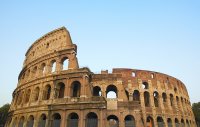
Worksheets and No Prep Teaching Resources
Reading Comprehension Worksheets
Ancient Rome

Ancient Rome
 Worksheets and No Prep Teaching Resources Reading Comprehension Worksheets Ancient Rome |
 Ancient Rome |
| edHelper's suggested reading level: | grades 7 to 9 | |
| Flesch-Kincaid grade level: | 8.39 |
|
Hippodromes and Amphitheaters
By Vickie Chao |

|
 1 The ancient Romans really liked to watch public games. To enjoy their pastimes comfortably, they erected numerous sports centers across the empire. All those sports centers were made of stone and concrete. Some, called hippodromes, were for horse and chariot races. Others, called amphitheaters, were for gladiator fights and venationes (combats between men and wild beasts.)
1 The ancient Romans really liked to watch public games. To enjoy their pastimes comfortably, they erected numerous sports centers across the empire. All those sports centers were made of stone and concrete. Some, called hippodromes, were for horse and chariot races. Others, called amphitheaters, were for gladiator fights and venationes (combats between men and wild beasts.) |
Create Weekly Reading Books
Prepare for an entire week at once! |
| Leave your feedback on Hippodromes and Amphitheaters (use this link if you found an error in the story) |
 |
Ancient Rome
|
 |
High School Reading Comprehensions and High School Reading Lessons
|
 |
Social Studies
|